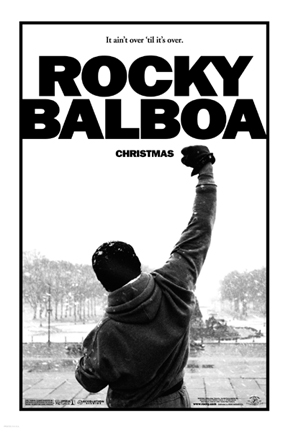ROCKY BALBOA
(2006, directed by Sylvester Stallone, 102 minutes)
BY DAN BUSKIRK
As the press cheers the return of Rocky Balboa to the big screen, you have to ask yourself: Is the public really crying out for another round with this mug, after 30 years? If the Riverview, the only movie theater in South Philly, draws only a three quarters-filled house at the advance screening, I’d say signs point to this fighter’s legs finally giving out.
Hearing the promising advance word, I’ll admit to being vaguely optimistic that, against all reason, the man who wrote the arm-wrestling epic “Over the Top” and the “Saturday Night Fever” sequel “Stayin’ Alive” had somehow located his muse at this late date. I figured maybe, with 16 years to ponder the character since “Rocky V,” Stallone had found a new angle on what was promised to be the last Rocky film. He wouldn’t dare to just remake the same underdog-against-the-odds saga one more time, would he?
But inspiration or not, the once-mighty Planet Hollywood co-founder had little choice but to resurrect the Rocky character, considering three of the last six films he starred in did not even make it to theaters. With his big-screen acting career in the lurch, Stallone gambles nothing and instead delivers another Rocky chapter that hits all the expected bases like an aging ballplayer on Old Timers’ Day.
So while this new installment may find Rocky mourning Adrian’s death, he still lives in the same run-down Philly neighborhood as he did in the first film, he still has Cuff and Link (the turtles, of course), Burt Young is still sputtering around as Paulie and, once the music kicks in, Rock will still punch meat and drink eggs and jump up and down atop the Art Museum steps. Just like a punchy fighter, Stallone seems to mechanically repeat the same knockout story over and over again
Rocky stands alone amongst Best Picture winners with its pointlessly long trail of diminishing-return sequels (how we ever dodged the bullet of Dances With Wolves 6: Full Moon Fever I’ll never know) and when I looked at the original last week its scrappy strengths were still apparent. Like Saturday Night Fever it is bleaker than people remember, while seconds after the triumphant stair-climbing training montage the character comes to the conclusion that he’s not in the same class as Creed and could never beat him. Later, just before the fight a little girl hands Rocky an American flag on his way to the ring. Sensing a pug from Philly would never be a believable patriotic icon he takes the flag awkwardly and gives it a few sheepish waves before handing it back. It’s the fake and show-bizzy Apollo Creed who comes to the ring dressed as Uncle Sam.
The dingy, rubble-strewn streets of the original are back but they don’t humanize the Everyman Rocky like they once did. Instead, Stallone stands out on the sidewalk, perfectly framed by dilapidated scenery and the effect is “Look at me, Sylvester Stallone! I’m a superstar and I’m walking around in Kensington!” And so he does, offering bits of simple-minded advice like “Don’t quit” and “life’s not easy” to assorted down-and-outers who show a tolerance for his empty pep talks that seems a bit foreign to the streets of Philadelphia.
So it was no surprise when the homegrown crowd started to chatter among themselves as Rocky, now a downright saintly figure, wanders around doing good deeds for old fighters, saving an impounded mongrel and helping out the down-on-her-luck neighborhood gal Marie (who briefly appeared as a bratty kid in the original film) and her corn-rowed son.
Here Marie is played by Geraldine Hughes, and she gives the only worthwhile performance in the film as the neighborhood barmaid whom Rocky installs as a hostess in his restaurant. This seems designed to turn into a romance, but Rocky’s pious demeanor keeps the relationship chaste as a Monk on Sunday.
For over an hour, Rocky delivers heartfelt homilies, while a minor-key version of “Gonna Fly Now” tinkles underneath him. And then, when you about can’t take it any more, the theme finally revs up, and the Rock starts a new training montage and then it’s fight night. His challenger, a spoiled heavyweight named Mason “The Line” Dixon is by far the least colorful opponent the Italian Stallion has met (Anthony Tarver, you are no Mr. T), and his inability to fill the shoes of the villain role saps the power from the final showdown. Stallone is more ambitious with this fight scene than in the earlier films, but he so randomly quick-cuts between color and black and white, through space and time, that I began to think his opponent had slipped some mescaline into Rocky’s water bottle between rounds.
Despite these trippy 10 rounds, no Indian jumps into Rocky’s soul to become his spiritual guide — and would he listen anyway? Despite the changes of time, this Rocky is a stubbornly “stay the course” type of strategist.
